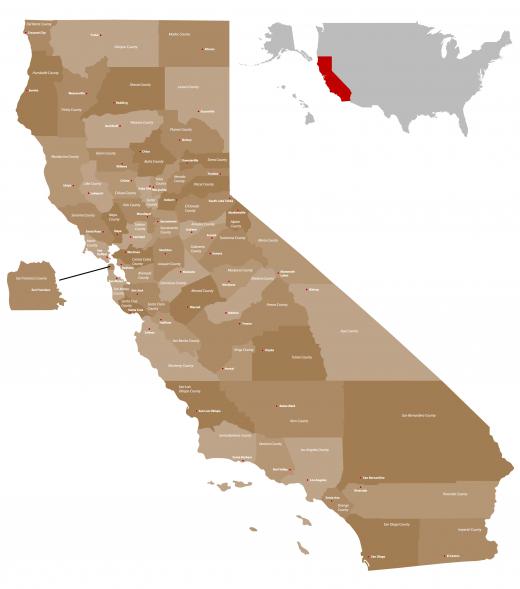What are Landslides?
 Mary McMahon
Mary McMahon
Landslides are downward flows of rock, dirt, and other materials. Landslides can cause a great deal of damage, especially when they are large, and they are a geological hazard of concern around the world, as they can happen anywhere and at any time. A number of steps can be taken to prevent landslides and reduce their severity, and these steps are often used in areas where landslides are common, such as the infamous Devil's Slide in California.
In a landslide, the materials are dry, and can include rocks, dirt, trees, and structures which happen to be pulled along with the falling material. Landslides can be caused by earthquakes, destabilization as a result of water flowing underground, the collapse of overhanging rocks, and the simple battle with gravity. Human activities such as heavy construction, undermining of the earth, and stripping groundcover like plants and trees can also trigger landslides. When a landslide involves mud and wet material, it is known as a mudslide; mudslides can follow storms and floods.

The land involved in a landslide is typically unstable. One of the most common reasons for instability is poor groundcover. Trees and plants, especially when they root deeply, can hold soil in place so that it cannot slide, even on very steep grades. If the groundcover is sparse or poorly rooted, rocks and loose materials can start to slip. Slides also occur on very steep grades, especially if the grades include overhangs.
Landslide disasters occur on a regular basis. A landslide can destroy homes, chew apart a highway, or trigger more catastrophic events such as flooding if it happens in the wrong place at the wrong time. Human settlements around the world are built near landslide-prone cliffs and mountains, which can result in tragic consequences. Geologic history has a number of examples of landslides which were large enough to move entire mountains, and in the modern era, several landslide disasters such as the Monte Toc landslide in Italy, the 1991 Pubjabi landslide in India, and the Khait landslide in Russia claimed thousands of casualties and dealt out considerable damage.
Techniques to manage landslides can include the establishment of retaining walls which trap landslides before they can cause damage, the growth of groundcovers to hold topsoil in place, and building codes which prohibit construction near landslide-prone areas so that structures will not be damaged when falls and slides occur. Human activities which can increase the risk of landslides may also be restricted, just as activities which contribute to avalanches are restricted in regions where avalanches are common.
AS FEATURED ON:
AS FEATURED ON:











Discussion Comments
I really enjoy reading your articles. This one really helped me with my research project. Continue doing these amazing and resourceful articles.
@waterhopper: My sister has lived in Canada for several years and recently told me of a catastrophic landslide that took place in Calgary, Alberta. There was a small mining town called Frank located in a valley of cliffs and mountains. Turtle Mountain was right by Frank.
In 1901, an excavation project was started to sink a mine shaft into the bowels of Turtle Mountain. This was done so that they would be able to mine the huge coal deposits in the mountain. Within a year, they had already created over 2300 feet of tunnels. It was then that they started feeling tremors. The tremors were ignored. By 1903, mining had become very productive. On April 29, 1903, half of the Turtle Mountain slid down a 2 km distance, burying the miners and residents and destroying over half of the town. It lasted for around 100 seconds. The town was wiped out and covered with tons of limestone boulders.
After a few days, the damage was really apparent. 76 people were buried alive and 75% of the homes in Frank Town were destroyed along with train tracks, bridges, and roads. It is considered to be Canada’s worst landslide.
@waterhopper: There are several landslides that have caused mass destruction and catastrophic loss of lives. On December 16, 1920 in Kansu, China, there was a huge landslide that left over 180,000 people dead. In 1949 in Khait, Tadzhikistan, USSR, over 12,000 people died from a landslide. These were definitely some of the most deadly landslides we have ever seen.
What are some of the most disastrous or famous landslides that have happened?
Post your comments